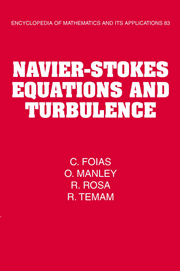Book contents
- Frontmatter
- Contents
- Preface
- Acknowledgments
- Chapter I Introduction and Overview of Turbulence
- Chapter II Elements of the Mathematical Theory of the Navier–Stokes Equations
- Chapter III Finite Dimensionality of Flows
- Chapter IV Stationary Statistical Solutions of the Navier–Stokes Equations, Time Averages, and Attractors
- Chapter V Time-Dependent Statistical Solutions of the Navier–Stokes Equations and Fully Developed Turbulence
- References
- Index
Chapter II - Elements of the Mathematical Theory of the Navier–Stokes Equations
Published online by Cambridge University Press: 14 August 2009
- Frontmatter
- Contents
- Preface
- Acknowledgments
- Chapter I Introduction and Overview of Turbulence
- Chapter II Elements of the Mathematical Theory of the Navier–Stokes Equations
- Chapter III Finite Dimensionality of Flows
- Chapter IV Stationary Statistical Solutions of the Navier–Stokes Equations, Time Averages, and Attractors
- Chapter V Time-Dependent Statistical Solutions of the Navier–Stokes Equations and Fully Developed Turbulence
- References
- Index
Summary
Introduction
The purpose of this chapter is to recall some elements of the classical mathematical theory of the Navier–Stokes equations (NSE). We try also to explain the physical background of this theory for the physics-oriented reader.
As they stand, the Navier–Stokes equations are presumed to embody all of the physics inherent in the given incompressible, viscous fluid flow. Unfortunately, this does not automatically guarantee that the solutions to those equations satisfy the given physics. In fact, it is not even guaranteed a priori that a satisfactory solution exists. This chapter addresses the means for specifying function spaces – that is, the ensembles of functions consistent with the physics of the situation (such as incompressibility, boundedness of energy and enstrophy, as well as the prescribed boundary conditions) – that can serve as solutions to the Navier–Stokes equations. An important point is made that the kinematic pressure, p, is determined uniquely by the velocity field up to an additive constant. Hence, one cannot specify independently the initial boundary conditions for the pressure. This observation leads naturally to a representation of the NSE by an abstract differential equation in a corresponding function space for the velocity field.
Two types of boundary conditions are considered: no-slip, which are relevant to flows in domains bounded by solid impermeable walls; and space-periodic boundary conditions, which serve to study some idealized flows (including homogeneous flows) far away from real boundaries.
- Type
- Chapter
- Information
- Navier-Stokes Equations and Turbulence , pp. 25 - 114Publisher: Cambridge University PressPrint publication year: 2001

